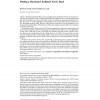101 search results - page 2 / 21 » Using Parsimony to Guide Maximum Likelihood Searches |
JACM
2006
13 years 5 months ago
2006
Abstract. Maximum likelihood (ML) is an increasingly popular optimality criterion for selecting evolutionary trees [Felsenstein 1981]. Finding optimal ML trees appears to be a very...
TCBB
2008
13 years 5 months ago
2008
Abstract-- The Maximum Parsimony problem aims at reconstructing a phylogenetic tree from DNA sequences while minimizing the number of genetic transformations. To solve this NP-comp...
BMCBI
2007
13 years 5 months ago
2007
Background: Maximum parsimony phylogenetic tree reconstruction from genetic variation data is a fundamental problem in computational genetics with many practical applications in p...
ICDAR
1999
IEEE
13 years 9 months ago
1999
IEEE
We present a method of classifying a pattern using information furnished by a ranked list of templates, rather than just the best matching template. We propose a parsimonious mode...
BIBE
2003
IEEE
13 years 10 months ago
2003
IEEE
Abstract— We analyze the performance of likelihoodbased approaches used to reconstruct phylogenetic trees. Unlike other techniques such as Neighbor-Joining (NJ) and Maximum Parsi...

